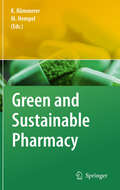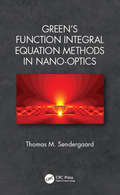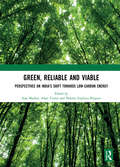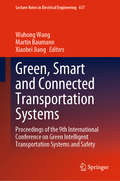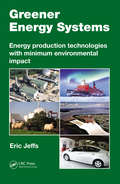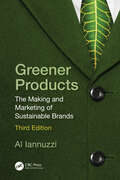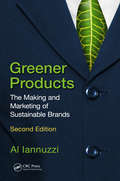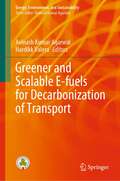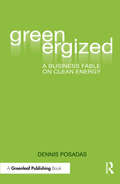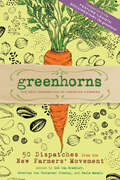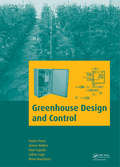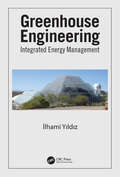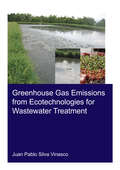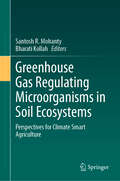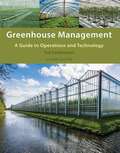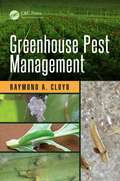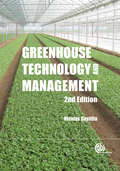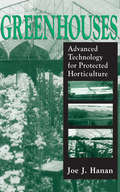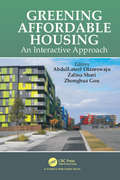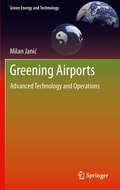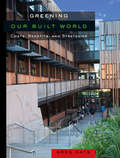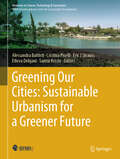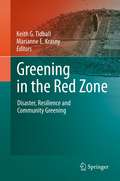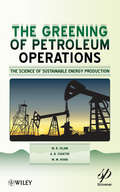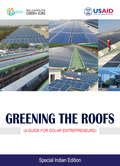- Table View
- List View
Green and Sustainable Pharmacy
by Maximilian Hempel Klaus KümmererWithin recent years pharmaceuticals have come into focus as contaminants of the environment (see for example Kümmerer, K. editor: Pharmaceuticals in the Environment). At the same time the issue of sustainable chemistry gained momentum. Bringing both together would result in sustainable pharmacy. Sustainable pharmacy is a totally new issue and approach. It addresses environmental, economical and social aspects of pharmacy. In the present stage the focus will be on environmental issues along the whole lifecycle of a pharmaceutical entity. That is dealing with resources and energy input but also with waste issues for example during the synthesis and production of an active pharmaceutical ingredient. Furthermore, it would also look on the compounds themselves and will aim to improve the degradability of the compounds after their use in the environment to reduce the environmental risk caused by pharmaceuticals in the environment. Another issue is the people using pharmaceuticals such as pharmacists, medical doctors and patients. How can they contribute to more efficient use of pharmaceuticals with less environmental burden and less risk for drinking water. The book "Sustainable Pharmacy" will address all these issues and will be the first one dealing with this important topic.
Green's Function Integral Equation Methods in Nano-Optics
by Thomas M. SøndergaardThis book gives a comprehensive introduction to Green’s function integral equation methods (GFIEMs) for scattering problems in the field of nano-optics. First, a brief review is given of the most important theoretical foundations from electromagnetics, optics, and scattering theory, including theory of waveguides, Fresnel reflection, and scattering, extinction, and absorption cross sections. This is followed by a presentation of different types of GFIEMs of increasing complexity for one-, two-, and three-dimensional scattering problems. In GFIEMs, the electromagnetic field at any position is directly related to the field at either the inside or the surface of a scattering object placed in a reference structure. The properties of the reference structure, and radiating or periodic boundary conditions, are automatically taken care of via the choice of Green’s function. This book discusses in detail how to solve the integral equations using either simple or higher-order finite-element-based methods; how to calculate the relevant Green’s function for different reference structures and choices of boundary conditions; and how to calculate near-fields, optical cross sections, and the power emitted by a local source. Solution strategies for large structures are discussed based on either transfer-matrix-approaches or the conjugate gradient algorithm combined with the Fast Fourier Transform. Special attention is given to reducing the computational problem for three-dimensional structures with cylindrical symmetry by using cylindrical harmonic expansions. Each presented method is accompanied by examples from nano-optics, including: resonant metal nano-particles placed in a homogeneous medium or on a surface or waveguide; a microstructured gradient-index-lens; the Purcell effect for an emitter in a photonic crystal; the excitation of surface plasmon polaritons by second-harmonic generation in a polymer fiber placed on a thin metal film; and anti-reflective, broadband absorbing or resonant surface microstructures. Each presented method is also accompanied by guidelines for software implementation and exercises. Features Comprehensive introduction to Green’s function integral equation methods for scattering problems in the field of nano-optics Detailed explanation of how to discretize and solve integral equations using simple and higher-order finite-element approaches Solution strategies for large structures Guidelines for software implementation and exercises Broad selection of examples of scattering problems in nano-optics
Green, Reliable and Viable: Perspectives on India’s Shift Towards Low-Carbon Energy
by Adair Turner Ajay Mathur Noëmie Leprince-RinguetResource-intensive practices of yesterday can no longer sustain the world. The future of our planet hinges on timely transitions to efficiency of resource-use across ecosystems of people, products, and processes. This will happen through transitions to low-carbon global energy systems. Against this, it is vital to take a closer look at the ongoing transitions in India. India is a country faced with the triple challenges of raising a substantial amount of its population out of poverty, shifting to a low-carbon economy, and fighting climate change. It is unquestionable that India’s energy demand and consumption will only continue to rise in the decades to come; nonetheless, with multiple synchronized steps in the right direction, India can set the wheel in motion to achieve its development goals while containing its carbon footprint. This book brings together the valued perspectives from key stakeholders in these transitions. Experts and practitioners from the mobility, clean energy, agriculture and energy efficiency sectors, among others, have shared their outlook on challenges that lie in the way of energy transitions in India, and offered solutions and next steps to move the country forward on the decarbonisation pathway. The overarching message is clear: the Indian energy sector of the future will be noticeably different from what it is today. Please note: This book is co-published with TERI Press, India. Taylor & Francis does not sell or distribute the Hardback in India, Pakistan, Nepal, Bhutan, Bangladesh and Sri Lanka
Green, Smart and Connected Transportation Systems: Proceedings of the 9th International Conference on Green Intelligent Transportation Systems and Safety (Lecture Notes in Electrical Engineering #617)
by Wuhong Wang Xiaobei Jiang Martin BaumannThese proceedings gather selected papers from the 9th International Conference on Green Intelligent Transportation Systems and Safety, held in Guilin, China on July 1-3, 2018. They feature cutting-edge studies on Green Intelligent Mobility Systems, the guiding motto being to achieve “green, intelligent, and safe transportation systems.” The contributions presented here can help promote the development of green mobility and intelligent transportation technologies to improve interconnectivity, resource sharing, flexibility and efficiency. Given its scope, the book will benefit researchers and engineers in the fields of Transportation Technology and Traffic Engineering, Automotive and Mechanical Engineering, Industrial and System Engineering, and Electrical Engineering alike.
Greener Energy Systems: Energy Production Technologies with Minimum Environmental Impact
by Eric JeffsRecent years have seen acceleration in the development of cleaner energy systems. In Europe and North America, many old coal-fired power plants will be shut down in the next few years and will likely be replaced by combined cycle plants with higher-efficiency gas turbines that can start up and load quickly. With the revival of nuclear energy, designers are creating smaller nuclear reactors of a simpler integrated design that could expand the application of clean, emission-free energy to industry. And a number of manufacturers now offer hybrid cars with an electric motor and a gasoline engine to charge the batteries on the move. This would seem to be the way forward in reducing transport emissions, until countries develop stronger electricity supply systems to cope with millions of electric cars being charged daily. Greener Energy Systems: Energy Production Technologies with Minimum Environmental Impact tackles the question of how to generate enough electricity, efficiently and with minimum environmental impact, to meet future energy needs across the world. Supplemented with extensive figures and color photographs, this book: Traces the development of electricity supply Explains energy production risks and how major accidents have influenced development Discusses the combined cycle, the preferred system for power capacity expansion in much of the world Looks at combined heat and power Addresses whether coal can continue to be a fuel for power generation Examines nuclear power generation Asks why shipping has not followed some of the world's navies into nuclear propulsion Considers how to electrify more transport systems Reviews the current state of renewable systems, particularly hydro and solar The book defines the key elements of greener energy systems, noting that they must be highly efficient, with rapid start up and loading; produce minimum emissions; and use simpler technology. The author has more than forty years of experience as an international journalist reporting on power-generation technologies and energy policies around the world. He concludes that there is no place for coal and that combined cycle, hydro, solar, and biomass must complement nuclear energy, which must serve more applications than just generating electricity.
Greener Products: The Making and Marketing of Sustainable Brands
by Al IannuzziSustainability and its competitive advantage are the goals of every company and any brand that wants to stay successful in the marketplace. Customers also gravitate to brands that manage sustainability issues well. Greener Products: The Making and Marketing of Sustainable Brands written by a renowned sustainability expert, continues to address the latest developments in the extremely fast-moving field of sustainability. The third edition is thoroughly updated, introduces new case studies, and includes a new chapter on green marketing. With over 40 case studies, it explores the best practices of leading global companies and helps readers learn what it is that makes them successful.New in the Third Edition: Presents, in a practical way, the best practices of sustainable brands in a global economy. Addresses the most current sustainability topics like circular economy, plastics in the environment, biodiversity, climate change, green chemistry, etc. Includes current marketing information on consumer trends to purchase greener products. Incorporates the latest pressures on companies to address sustainability, retailer programs, business-to-business expectations, ESG raters, rankers, and stock funds. Covers best practices of companies from various industries on how to make and market greener products. Provides current tools for making products more sustainable and methods on how to market sustainable improvements. Includes lecture slides available upon request for use in the classroom. This book serves senior undergraduate and graduate students in programs focused on sustainability, as well as academics and corporate sustainability leaders. The previous versions have been used to teach courses on sustainability, product improvement, introduction to sustainability, green marketing and sustainability, and sustainability policy. Any university that teaches a course on sustainability and any company or individual interested in making and marketing more sustainable products would benefit from the new edition of this book.
Greener Products: The Making and Marketing of Sustainable Brands, Second Edition
by Al IannuzziWritten by a renowned sustainability expert, Greener Products: The Making and Marketing of Sustainable Brands, Second Edition makes the case for why the people and the planet need products to be made in a different, more sustainable way. The growth of the global middle class, with an additional 3 billion people expected to enter the consumer market by 2030, is putting an unprecedented demand on resources and straining the global supply of raw materials, fossil fuels, food and water. This book provides insights on how to raise the bar on product development and investigates the best practices for making and marketing sustainable brands. Over 40 case studies are analyzed in this book and summarized for the reader to easily see what it is that makes leading companies successful. Analysis on marketing campaigns and greener product development range from leading companies like Apple, Nike, Samsung Electronics, BASF, GE, Johnson & Johnson, Unilever, and Method. New updated content in this second edition includes: New developments like the United Nations Sustainable Development Goals with concepts of biomimicry, circular economy, emerging issues management, and eco-innovation. Novel tools and examples for bringing sustainable products to market. New chapter dedicated to natural capital. Analysis of current green marketing methods and market trends. Best practices for making and marketing sustainable brands. For more information, visit the author's book website at www.greenerproducts.biz.
Greener and Scalable E-fuels for Decarbonization of Transport (Energy, Environment, and Sustainability)
by Avinash Kumar Agarwal Hardikk ValeraThis book highlights ways of using gaseous and liquid e-fuels like hydrogen (H₂), methane (CH₄), methanol (CH₃OH), DME (CH₃-O-CH₃), Ammonia (NH₃), synthetic petrol and diesel, etc in existing engines and their effects on tailpipe emissions. The contents also cover calibration and optimization procedure for adaptation of these fuels. the volume also discusses the economical aspect of these fuels. Chapters include recent results and are focused on current trends of automotive sector. This book will be of interest to those in academia and industry involved in fuels, IC engines, engine instrumentation, and environmental research.
Greenergized: A Business Fable on Clean Energy
by Dennis PosadasRenewable energy versus fossil fuels: the debate rages on, worldwide. At stake is nothing less than the protection of our planet from the ravages of climate change. But the costs involved in making the switch to clean energy are daunting. How do we pay for solar and wind energy? Do we scrap all our gasoline-driven autos? How do we move forward?Although the importance of this topic is hard to overstate, it nevertheless consistently fails to engage at the level that it so patently needs to. This is what has led technology expert and seasoned commentator Dennis Posadas to approach the issues in a new and intriguing way. Posadas understands that we respond best to narratives, and that is why he has written what he describes as a "green thinking fable". In this fable, we meet Daniel, a young graduate of the fictional Oriental College, who is thrust into a debate between José, an oil man, and Professor Ruiz, an advocate of clean energy. We follow the lines of argument as Daniel's awareness increases, and he experiences a paradigm shift in his thinking. We see how his short-term outlook focusing on the cost of renewable energy evolves into long-term thinking about the cost of not making the shift to renewables. Posadas's business fable puts the issues in front of the general reader in an engaging and digestible way. It covers concepts such as solar, wind, electric vehicles, waste to energy, feed-in-tariffs, carbon tax, intermittent sources, cost of fossil fuels, health impact of fossil fuel use, energy efficiency, and other relevant topics necessary for understanding this debate. The story and characters may be fictional, but the situations and the technology discussions are based on current facts. Decide for yourself where you stand on the renewables versus fossil fuels debate, and discuss this story with your friends and colleagues. Greenergized is a much-needed route into the issues surrounding the most serious debate our generation faces. And it pulls off the brilliant trick of being highly readable at the same time.
Greenhorns: 50 Dispatches from the New Farmers' Movement
by Zoe Ida Bradbury Severine Von Fleming Paula ManaloThe Greenhorns are a community of more than 5,000 young farmers and activists committed to producing and advocating for food grown with vision and respect for the earth. <P><P>This book, edited by three of the group’s leading members, comprises 50 original essays by new farmers who write about their experiences in the field from a wide range of angles, both practical and inspirational. <P><P>Funny and sad, serious and light-hearted, these essays touch on everything from financing and machinery to family, community building, and social change.
Greenhouse Design and Control
by Arturo Molina Pedro Ponce Brian MacCleery Paul Cepeda Esther LugoThis book deals with different types of greenhouses, materials, structures, advanced control techniques and tendencies that are needed for designing and controlling an advanced greenhouse. The control system is presented as an integral system which covers the explanation of basic and advanced concepts for a real time controller. Also, structural analysis is introduced, whereby mechanical design is regarded as a key factor. The book incorporates simulations and experimental results, and utilizes LabVIEW and ADAMS software. Finally, it provides a perspective on the present state and future of greenhouses globally.
Greenhouse Engineering: Integrated Energy Management
by Ilhami YildizSustainable energy development concept requires and maintains multiple linkages among energy production, energy consumption, human well-being, and environmental quality. Greenhouse Engineering: Integrated Energy Management puts forward the concept of integrated energy management and modeling pertinent to greenhouses that will eventually help reduce the load on power grids, demand for fossil fuels and water, and supply CO2 for the greenhouse production. This book helps enhance the competitive position of the global greenhouse industry by introducing economically, environmentally and socially sustainable technologies and management strategies. Exclusive title on integrated energy management approach for greenhouse designing Addresses energy for heating concept Includes case studies from real work greenhouse systems Incorporates a design/energy management approach Contains updated material on greenhouse heating with examples and case studies Aimed at researchers, professionals, and students in the fields of energy systems, mechanical, agriculture, and biosystems engineering.
Greenhouse Gas Emissions from Ecotechnologies for Wastewater Treatment
by Juan Pablo Silva VinascoEcotechnologies for wastewater treatment (EWWT) have been used as a cost-effective alternative to conventional wastewater treatment methods for improving the removal of organic carbon, nutrients and pathogenic microorganisms from wastewater. However, due to biochemical transformations of organic matter and nutrients EWWT are net sources of CO2, CH4 and N2O greenhouse gases (GHGs), which may be transferred into the atmosphere contributing to global warming. Greenhouse Gas Emissions from Ecotechnologies for Wastewater Treatment provides scientific information about greenhouse gas, such as CO2, CH4 and N2O, generation and emissions from different municipal EWWT. The main EWWT considered in this book are anaerobic ponds, facultative ponds, duckweed-based ponds, and a freshwater natural wetland perturbed by anthropogenic activities such as wastewater discharge and nutrients from agricultural run-off. The book includes a full literature review of recent publications about GHGs emissions from EWWT. It also introduces the calculation of GHGs flux using a static chamber technique. Besides, the book presents information on the influence of environmental factors such as temperature, pH, DO, and nutrients on GHG emissions produced in EWWT under tropical conditions. This book will be a useful reference for researches and students interested in the broader area of water and climate change subjects. The publication may also be of interest to policy makers concerned with climate change, water sector planning, and wastewater treatment.
Greenhouse Gas Regulating Microorganisms in Soil Ecosystems: Perspectives for Climate Smart Agriculture
by Santosh R. Mohanty Bharati KollahThis volume comprehensively covers soil microbial processes that regulate the flux of greenhouse gasses (GHG) from agricultural soils, in an effort to address how GHG regulating microbes can be used to mitigate harmful climate change impacts on agriculture. The chapters define the linkages among soil microbial functioning, crop responses, ecosystem functioning, and GHG cycling processes. The book is framed through three major theme, including source and sink of GHG, microbial processes regulating GHG, and agricultural strategies and technologies to mitigate GHG emissions. The chapters highlight the fundamentals of soil microbial diversity and interactions with climate changing factors, soil carbon dynamics in response to different agricultural practices, conservation agriculture strategies to reduce GHG emissions from agriculture, and climate change mitigation through organic and climate-smart farming. The book is intended for policy makers, students, and researchers of environmental science, agriculture, soil science, and soil microbiology.
Greenhouse Management: A Guide To Operations and Technology
by Ted GoldammerGreenhouse Management: A Guide to Operations and Technology is a complete reference book on greenhouse technologies and operations, and the science of growing crops. Written in laymen’s terms, the book systematically starts the reader off by providing an in-depth discussion on greenhouse structures, design, and glazing; heating, cooling, and environmental control systems; growing media; temperature and lighting; carbon dioxide enrichment; plant nutrition, irrigation, and fertigation; seed/plant propagation; chemical growth regulation; and pest management. Finally, a series of appendices provide numerous data relevant to greenhouse management and operations. The information in this book is distilled from a variety of sources, including scientific literature, extension publications, trade publications, reader feedback, and industry experts, who have generously shared their years of experience. This book also has the added value of numerous citations to more in-depth discussion on many topics. The book is thoughtfully organized in an easy-to-read format presenting a seamless flow of topics within chapters. Greenhouse Management has removed some of the intuition and guesswork in understanding greenhouse operations. The result is a more consistent product of higher quality providing a practical “real world” application of greenhouse operations. The primary audience includes growers, technical industry representatives, and university horticulture students.
Greenhouse Pest Management (Contemporary Topics in Entomology)
by Raymond A. CloydAs the sustainable agriculture movement has grown, there has been a dramatic increase in the production of horticultural crops in greenhouses worldwide. Although there are numerous publications associated with pest management in greenhouses, Greenhouse Pest Management is the first comprehensive book on managing greenhouse arthropod pests, particula
Greenhouse Technology and Management
by Nicolas Castilla Esteban BaezaGreenhouse cultivation has expanded in recent decades with increased demand for horticultural production. This book covers current technologies and management practices of general greenhouse production, with a particular emphasis on plastic greenhouses and vegetable growing. The author begins by addressing the natural greenhouse microclimate, in the context of managing greenhouse systems such as ventilation, cooling, heating, carbon dioxide enrichment, light management, crop physiology, greenhouse design and construction criteria. The book then moves on to cover other issues of greenhouse management including irrigation and fertilization, soil and substrate cultivation, plant protection, regulation, economic analysis, environmental impact, and post-harvest, production strategies and marketing. Providing an integrated approach to greenhouse production this practical text aims to provide clear advice on optimising the yield and quality of crops grown under greenhouse conditions.
Greenhouses: Advanced Technology for Protected Horticulture
by Joe J. HananA greenhouse provides an essential means of livelihood to its owner and must be economically practical for the particular climate in which it stands. Greenhouses: Advanced Technology for Protected Horticulture addresses the major environmental factors of light, temperature, water, nutrition, and carbon dioxide, and features extensive discussions of greenhouse types, construction, and climate control. The book highlights technology such as hydroponics, computer control of environments, and advanced mathematical procedures for environmental optimization. Greenhouses: Advanced Technology for Protected Horticulture is the definitive text/reference for the science of greenhouse engineering and management.The author Dr. Joe J. Hanan, Professor Emeritus of Colorado State University, is the recipient of the Society of American Florists' (SAF) 2000 (Millenium) Alex Laurie Award for Research and Education. The Alex Laurie Award is presented annually to an individual who has made broad-scope, long-lasting contributions to the floriculture industry through research or education. The award is named for Alex Laurie, a professor at The Ohio State University, who pioneered work in many areas of floriculture."Joe is one of the most precise floricultural researchers I have known," said Dr. Gus De Hertogh, Chairman of SAF's Research Committee. "That excellence is reflected in his latest book, Greenhouses, Advanced Technology for Protected Horticulture, which was published in 1998, nine years after his official 'retirement.'"
Greening Affordable Housing: An Interactive Approach
by Abdullateef Olanrewaju Zalina Shari Zhonghua GouBooks on green building theories, principles and strategies applicable to life cycles of all kinds of buildings and building types are already widely available. However, those specifically on greening affordable housing that guide various housing stakeholders at different life cycles are still very limited. This book intends to fill this gap. Integrating green building enables stakeholders to address the environmental component that has not traditionally been seen as an integral part of affordable housing development. The book presents theories and principles with practical methods, strategies and processes not only to make affordable housing green but also to support economic stability and social equity.
Greening Airports
by Milan JanićGreening Airports considers the "greening", i.e., more sustainable development, of the entire air transport system - airports, air traffic control, and airlines - that could be achieved by the development and implementation of advanced operations and technologies. A broad overview of the general concept is given at the start of Greening Airports, which then goes on to provide a system for monitoring and assessing the level of greening of both the air transport system and individual airports. These are followed by analysis and modelling of the potential effects of particular advanced operations and technologies on the greening of airports and their local airspace. These include: the development of a large airport into a multimodal transport node by connecting it to a high speed rail network;the use of operations supported by new and existing air traffic control technologies to increase landing capacity of existing runways;the use of liquid hydrogen as a commercial aviation fuel; andthe improvement of airport ground accessibility by a light rail rapid transit system. Greening Airports is written for researchers, planners, operators and policy makers in air transport.
Greening Our Built World: Costs, Benefits, and Strategies
by Greg Kats"Green" buildings--buildings that use fewer resources to build and to sustain--are commonly thought to be too expensive to attract builders and buyers. But are they? The answer to this question has enormous consequences, since residential and commercial buildings together account for nearly 50% of American energy consumption--including at least 75% of electricity usage--according to recent government statistics. This eye-opening book reports the results of a large-scale study based on extensive financial and technical analyses of more than 150 green buildings in the U.S. and ten other countries. It provides detailed findings on the costs and financial benefits of building green. According to the study, green buildings cost roughly 2% more to build than conventional buildings--far less than previously assumed--and provide a wide range of financial, health and social benefits. In addition, green buildings reduce energy use by an average of 33%, resulting in significant cost savings. Greening Our Built World also evaluates the cost effectiveness of "green community development" and presents the results of the first-ever survey of green buildings constructed by faith-based organizations. Throughout the book, leading practitioners in green design--including architects, developers, and property owners--share their own experiences in building green. A compelling combination of rock-solid facts and specific examples, this book proves that green design is both cost-effective and earth-friendly.
Greening Our Cities: A Culmination of Selected Research Papers from the International Conferences on Green Urbanism (GU) – 6th edition and Urban Regeneration and Sustainability (URS) – 2022 (Advances in Science, Technology & Innovation)
by Alessandra Battisti Cristina Piselli Eric J Strauss Etleva Dobjani Saimir KristoThis thought-provoking book takes readers on a captivating journey through the realms of green urbanism, urban regeneration, and urban design, development, and preservation, providing an exploration of innovative approaches to creating sustainable and thriving cities of the future.Discussing the pressing challenges of urban environments, this book offers practical insights for architects, urban planners, researchers, and sustainability enthusiasts. It introduces cutting-edge strategies for sustainable urban mobility, energy-efficient designs, and nature-based solutions implementation while showcasing case studies and comprehensive analyses that shed light on the complexities of urban regeneration. Moreover, this volume uncovers the importance of preserving cultural heritage and its role in shaping vibrant communities. With its informative and engaging narrative, this book equips readers with valuable knowledge to make a positive impact on their urban surroundings. It deepens their understanding of urban challenges and illuminates ways they can contribute to transforming our cities toward a more sustainable and vibrant future.
Greening in the Red Zone: Disaster, Resilience and Community Greening
by Marianne E. Krasny Keith G. TidballCreation and access to green spaces promotes individual human health, especially in therapeutic contexts among those suffering traumatic events. But what of the role of access to green space and the act of creating and caring for such places in promoting social health and well-being? Greening in the Red Zone asserts that creation and access to green spaces confers resilience and recovery in systems disrupted by violent conflict or disaster. This edited volume provides evidence for this assertion through cases and examples. The contributors to this volume use a variety of research and policy frameworks to explore how creation and access to green spaces in extreme situations might contribute to resistance, recovery, and resilience of social-ecological systems.
Greening of Petroleum Operations
by A. B. Chhetri M. M. Khan M. Rafiq IslamThe Future of Petroleum OperationsThis state-of-the-art text analyzes some of the most contentious issues in the energy industry, covering new and greener processes for engineers and scientists and urging them to move petroleum operations closer to sustainability. Although petroleum is still the world's most diverse, efficient, and abundant energy source, there is a growing initiative from global political and industry leaders to "go green," because of climate concerns and high gasoline prices. This book investigates and details how to do that.This groundbreaking new volume:Explains why current petroleum industry practices are inherently unsustainable and offers unique new solutions for "greening" the petroleum industryDiscusses hot-button issues, such as global warming, carbon sequestration, zero-waste management, and sustainabilityShows engineers and scientists how to implement the processes necessary to be more environmentally consciousOffers, for the first time, a new theory that certain carbons do not contribute to global warming, but their origin and the processes involved doPraise for The Greening of Petroleum Operations"The book proposes a paradigm shift in energy management. It correctly identifies root causes of environmental impact of current petroleum production operations. With proper science, the book shows that fossil fuel production and utilization are inherently sustainable as long as natural materials and energy sources are used.... This book has the potential of revolutionizing energy management practices."--Farouq Ali, Honorary Professor of Oil and Gas Engineering, University of Calgary
Greening the Roofs: A Guide for Solar Entrepreneurs
by Tanmay BishnoiThis handbook on Greening the Roofs: A Guide for Solar Entrepreneurs deals with the subject of how an individual can enter the solar PV domain, which includes the major topics such as, carry out market research and prepare a cost estimate for a rooftop solar photovoltaic plant, prepare site feasibility report, manage solar PV project for its entire lifecycle, entrepreneurship skills, maintain personal health and safety at project site. Solar developers, EPCs, and other stakeholders have provided their guidance and support in detailing the activities to be performed by aspiring entrepreneurs in the solar PV domain, which has helped in the development of this manual and making it a practical guide.
